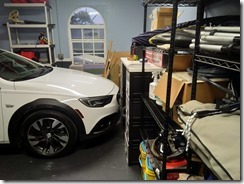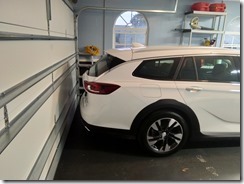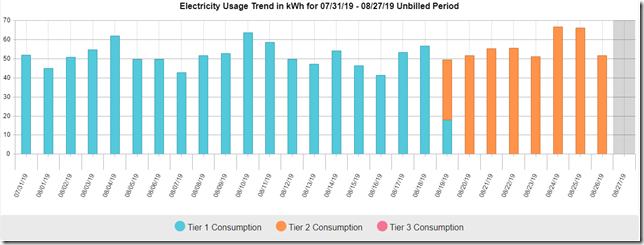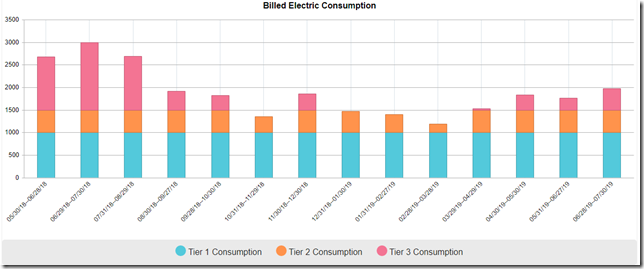In posts leading up to this one, I’ve been talking about my garage and new cars. Well, I finally got the new car and got in it the garage, only barely.
And I mean barely. And with that car in the garage, there is no room for the other car. I’m supposed to have a 2-car garage, and even so, I would classify the MX5 as a half-car, but still, there’s not enough room. So that’s that.
Now, all about this new car. As you see, it is a station wagon. There’s only a handful of wagon models you can buy new in the US right now, and this particular one, a Buick Regal TourX, gets zero marketing and has zero recognition. I saw this car once on display in a mall back in 2018, and have never seen one since. So suffice to say, this is a rare vehicle.
The TourX is rare because it’s really low production volume. There’s aren’t many buyers for wagons, so dealerships don’t order many and so no one ever buys them and the cycle feeds on itself. When I decided on a car to buy – a wagon – I looked at my available options and this one was the most economical. Well, it was economical for reasons relating to its unpopularity. Dealers wanted to sell these things and not so they could order more; they just wanted rid of them. In my own research, I saw that the 2020 model is coming soon and there are still 2018 models being sold new.
I haven’t purchased a car in nine years. This time around, I utilized a car buyer service – a person who would search for my car, negotiate a good price, manage all the paperwork with the dealer and basically make the process as easy as possible for me. When I first got started, I laid out all my criteria and within an hour, he had found me a car. When he ran the numbers, I was pretty underwhelmed.
The TourX can run up to $40k with all available options, and that is what this particular car had. So, $40k MSRP and with all discounts and haggling, I could get it for $35k. After all the taxes and fees were added in, I would pay $38k. I don’t know… I understand taxes and stuff, but a final price only $2k less than MSRP didn’t do it for me. And it was about $6k more than I was willing to finance anyway. So I turned it down.
The buyer went back to work and found another car with fewer options (but all the ones I wanted). The MSRP was $38k, sale price of $31k, final price of $34k. That was doable, so I agreed to the offer and we went through the complete sale process, which wasn’t all that bad. The car was transferred from one dealership to another where I would actually make the purchase. I gave it a brief test drive and no red flags were raised, mechanically. The car did have roof racks, which I didn’t want, but I determined I could just uninstall them. And after two hours at the dealership, I went home with a new car.
It’s been a couple days now, and some of the reality is hitting me. The first weird thing I experienced was a warning popping up on my dash: washer fluid low. Ok, whatever, I can buy a $3 jug of fluid and top it off. I would have assumed the dealer would have checked all that stuff during the “dealer prep” or whatever that BS service is.
When I popped the hood to fill the washer fluid, I was left aghast. There were leaves all jammed up under the cowl. Not just a few leaves, literal handfuls of leaves. And the plastic shrouds throughout the engine bay were not just dusty, but had a layer of dirt on them. This hood had not been raised in many, many months. Yes, the exterior of the car had been washed and the tires glossed up, but there was no detailing of this car in any sense of the word.
As I was pouring the washer fluid in, my astonishment grew. It just kept taking it. I poured the entire gallon. All of the washer fluid in the reservoir had evaporated in the time this car was sitting on the lot. And the mass of leaves reaffirmed just how long the car was sitting idle and suggested it was not even stored on the primary lot, but in a grass lot back by a tree line. I found out where the original dealer was located and did some quick math on the mileage for transportation and my test drive. I then determined this car had never been driven once. It left that original dealer on its way to me with probably about 10 miles on the odometer.
This poor car. It came to the dealer and was completely neglected for its entire life. Yeah, yeah, of course cars don’t have feelings, but everything deserves a small level of care. And a dealer should care for each and every vehicle in their possession. These are going to be in someone’s family soon (or not soon in cases like this), and they deserve to be treated well until that time comes.
Now, I feel a little conflicted. I mean, I got a great deal on a car – $7k off sticker price – and I didn’t have to deal with salespeople or haggling. It was a very low-effort transaction and I can recognize it was probably a low-profit transaction for the dealer. But at the same time, I still would expect one of the two dealers involved would have opened the hood and at least noticed the mess, or checked the fluid levels. The bottom line is that I feel like I purchased a car from auction and not from a dealership. Was I expecting to build a relationship with that dealer? No way; they are 40 minutes away from my house. I have dealerships closer to my home and my workplace I would utilize first. Did I still expect to be wowed by the “new car purchase experience”, where I can show the car off to everyone? Sure. I mean, doesn’t everyone pop the hood and show off how clean and new everything is (instead of dirt, leaves, and a post-it note that says “do not turn off”)? Show off every feature of the car like the power liftgate (which would reveal dusty and dirty rubber seals)?
But, I got a good deal, right? Now I just need to spend some personal capital on a detailed cleaning of every inch of the vehicle. Then the TourX will be mine and it won’t need to dwell on its miserable early life alone in a back lot.



